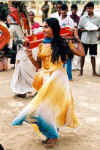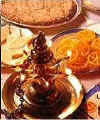|
|
the-south-asian.com January 2003 |
||||
|
JANUARY 2003 Contents Swami
Agnivesh & Music Ustad
Amjad Ali Khan Heritage
Books 'India
in Slow Motion' Serialisation
of 'Knock at every alien Events South Asian
Events in Lehngas - a limited collection Books
|
|
||||
|
Page 2 of 2
Avuruddha – Sri Lanka's symbol of harmony (cntd.) by Rajika Jayatilake
Avuruddha The world at large assumed that the Sinhalese and the Tamils were killing each other on the streets. They could not envisage racial harmony amidst a war where a handful of people fought for a separate state. Come April, and one finds a heartwarming chapter of two races who believe in harmonious living and celebration. The Sinhalese and the Tamils celebrate a common traditional New Year in the month of April, originally harvesting thanks giving. This marks the passage of the sun from Pisces to Aries. Traditional customs are observed on this day with merrymaking and fun and games and lavish hospitality. Although there might be some slight variations in customs, the Sinhalese and the Tamils celebrate the same event and find amity in their beliefs.The real spirit of the Sinhalese and Tamil New Year is seen in the villages – as it is a festival focused on the harvest. The New Year falls on the 13th or 14th
day of April, preceded by at least The day prior to the Sinhala and Tamil
New year is one of anticipation. Migrants to cities, return to their
ancestral homes. The cooking is over, the hearth cleaned, fires
extinguished, with fresh pots and pans now awaiting the preparation of the
first meal of the new year. The ensuing period, astrologically prescribed is
a time for complete relaxation. All activities are suspended and a lull
ensues, as a nation waits for the dawning of the new year.
_____________________
|
|||||
| Copyright © 2000 - 2003 [the-south-asian.com]. Intellectual Property. All rights reserved. | |||||
| Home | |||||


